Diversified Chemical Structures and Bioactivities of the Chemical Constituents Found in the Brown Algae Family Sargassaceae
Abstract
1. Introduction
2. Chemistry and Biological Activities of the Compounds from the Sargassaceae Family
2.1. Terpenoids
2.1.1. Monoterpenoids
2.1.2. Sesquiterpenoids
2.1.3. Diterpenoids
Norditerpenoids

Acyclic Diterpenoids
- C-12 Oxidized Congeners
- C-13 Oxidized Congeners
- Non C-12/C-13 Oxidized Analogs

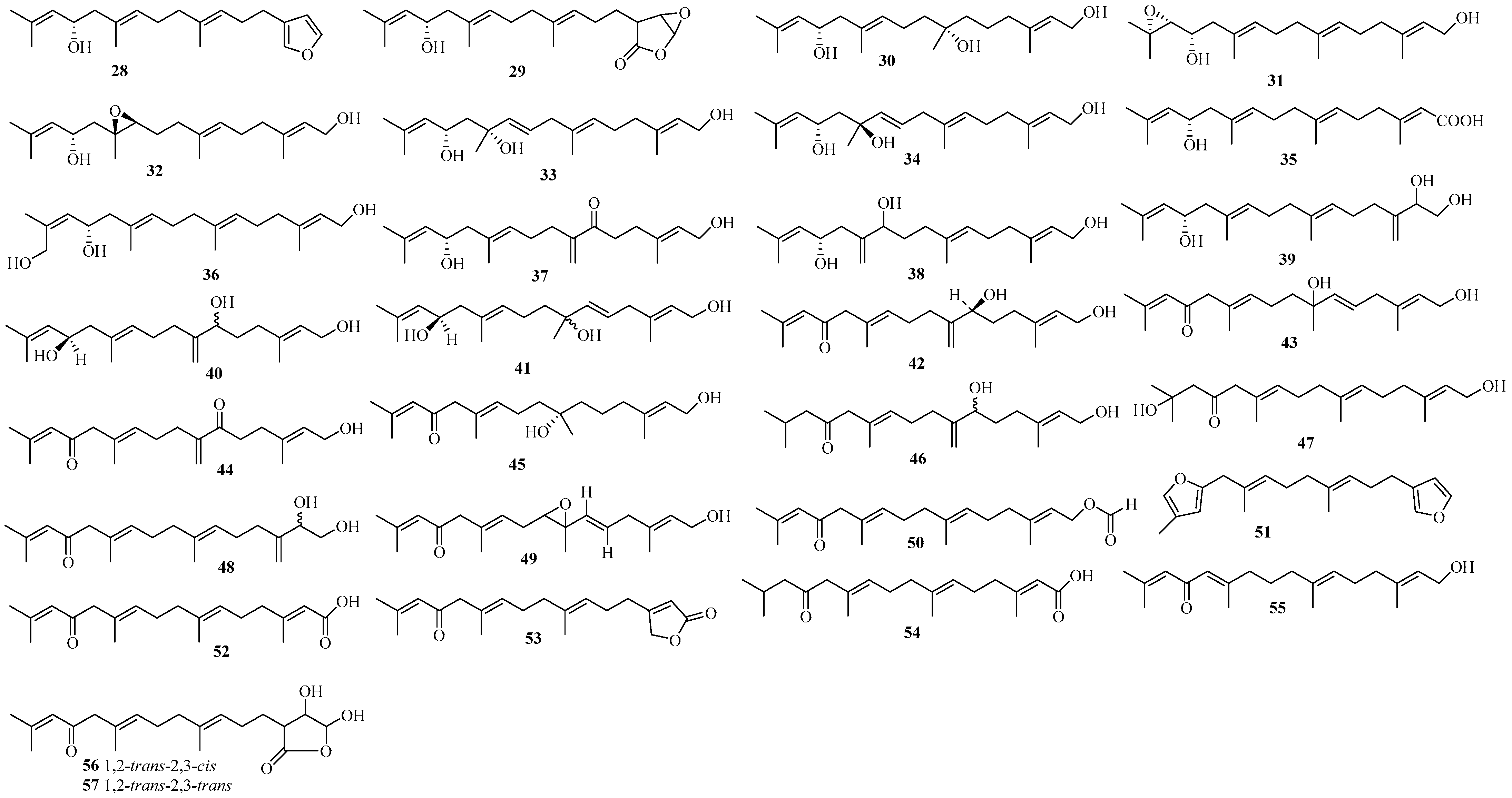

Hydroazulene Diterpenoids

Xenicane Diterpenoids

2.1.4. Nor-Dammarane Triterpenoids
2.1.5. Meroterpenoids
Terpenyl-Quinones/Hydroquinone Analogs
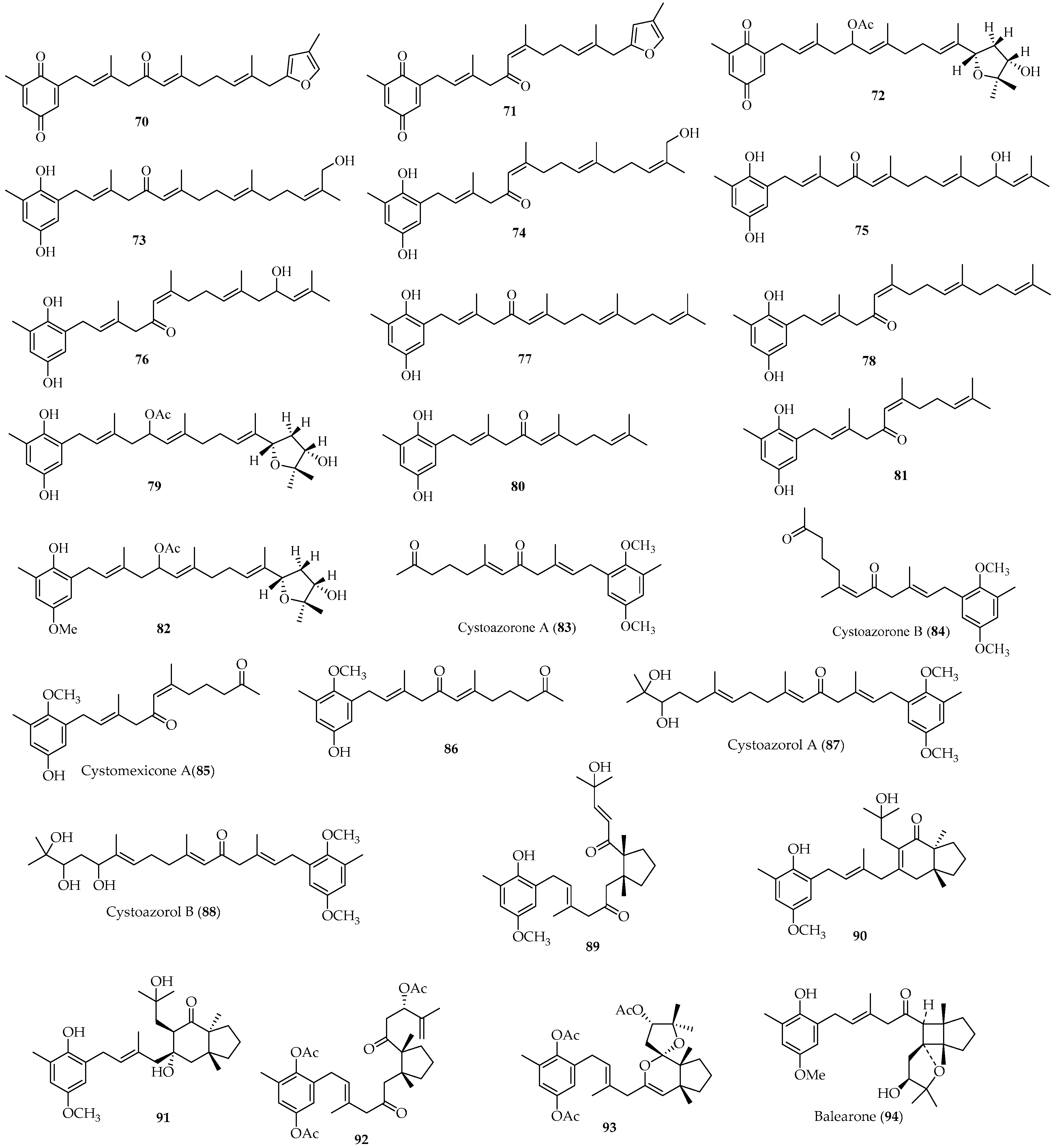
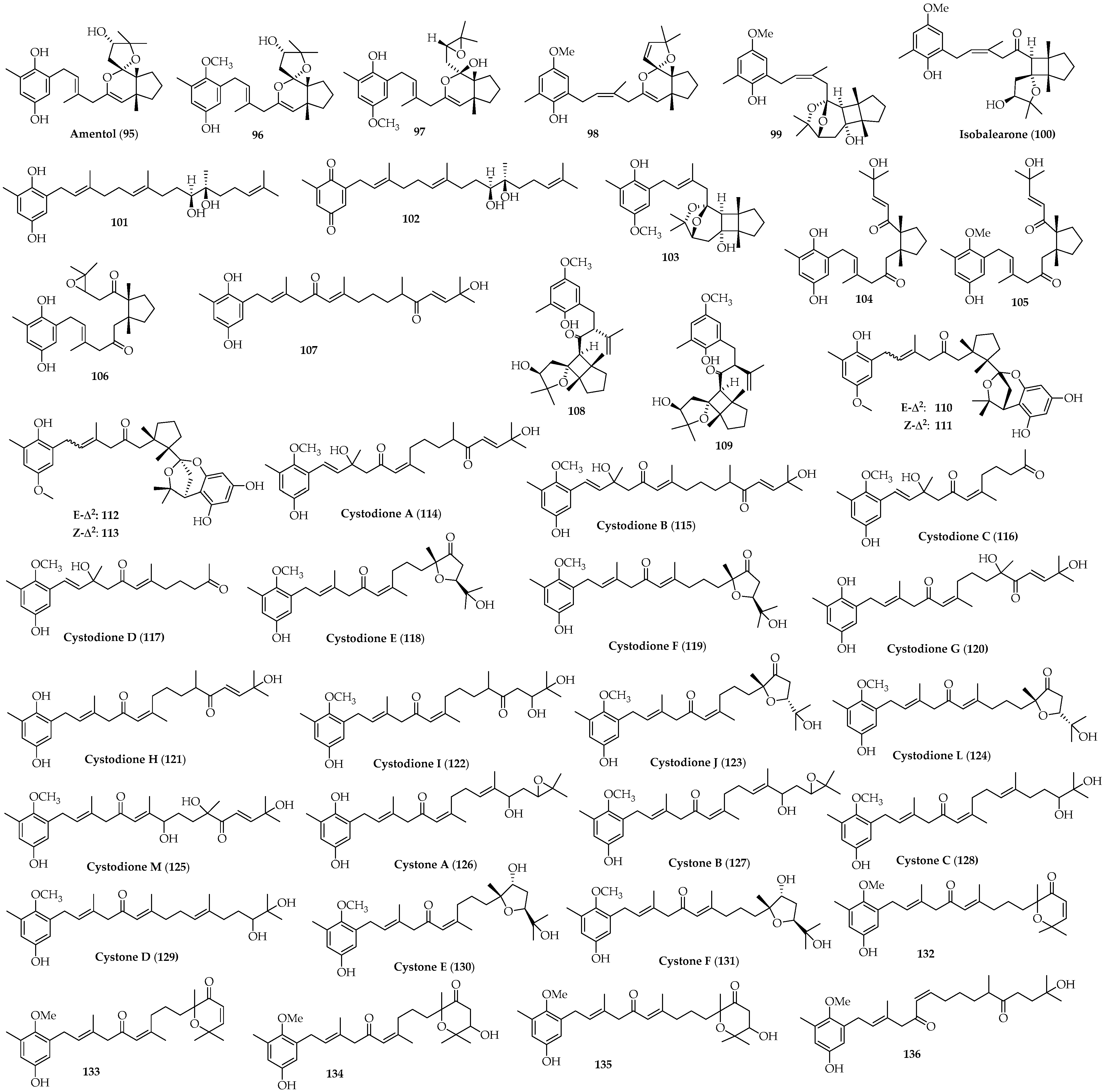
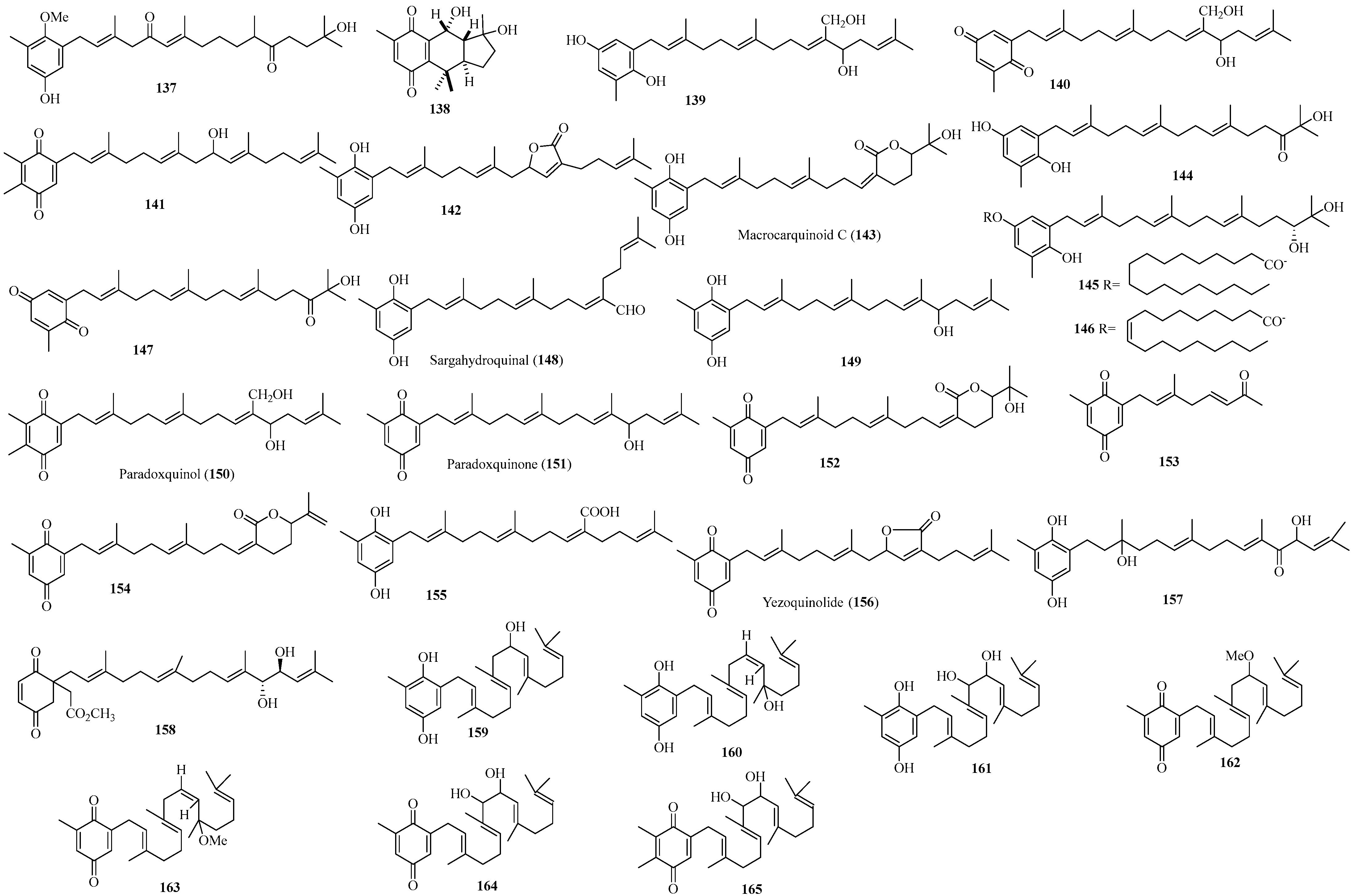
Chromenes
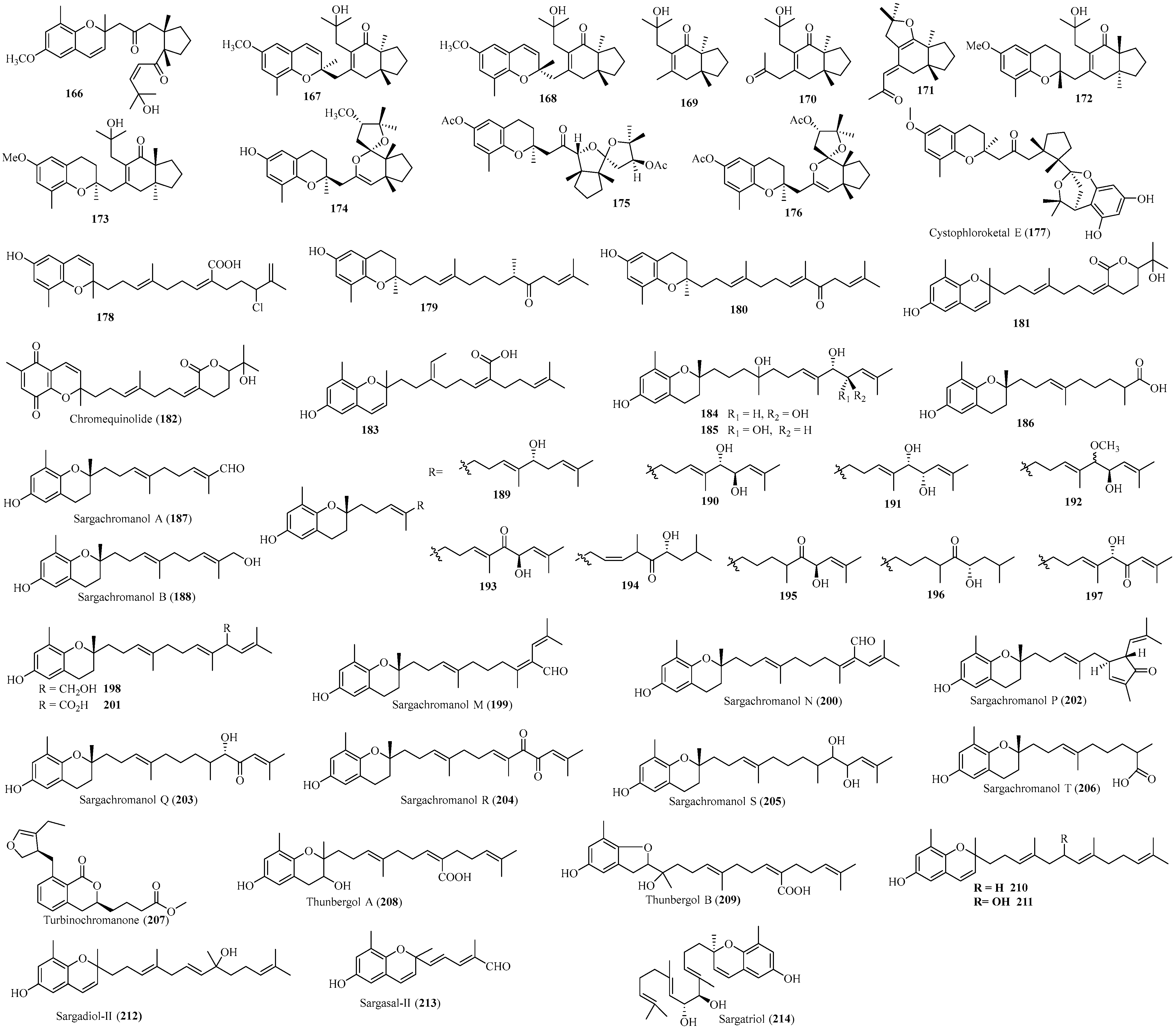
Nahocols/Isonahocols

2.2. Phloroglucinols
2.2.1. Monomeric Phloroglucinols

2.2.2. Phlorotannins
Fucophlorethols
Hydroxyphlorethols
Carmalols
Phlorethofuhalols
Fuhalols and Others





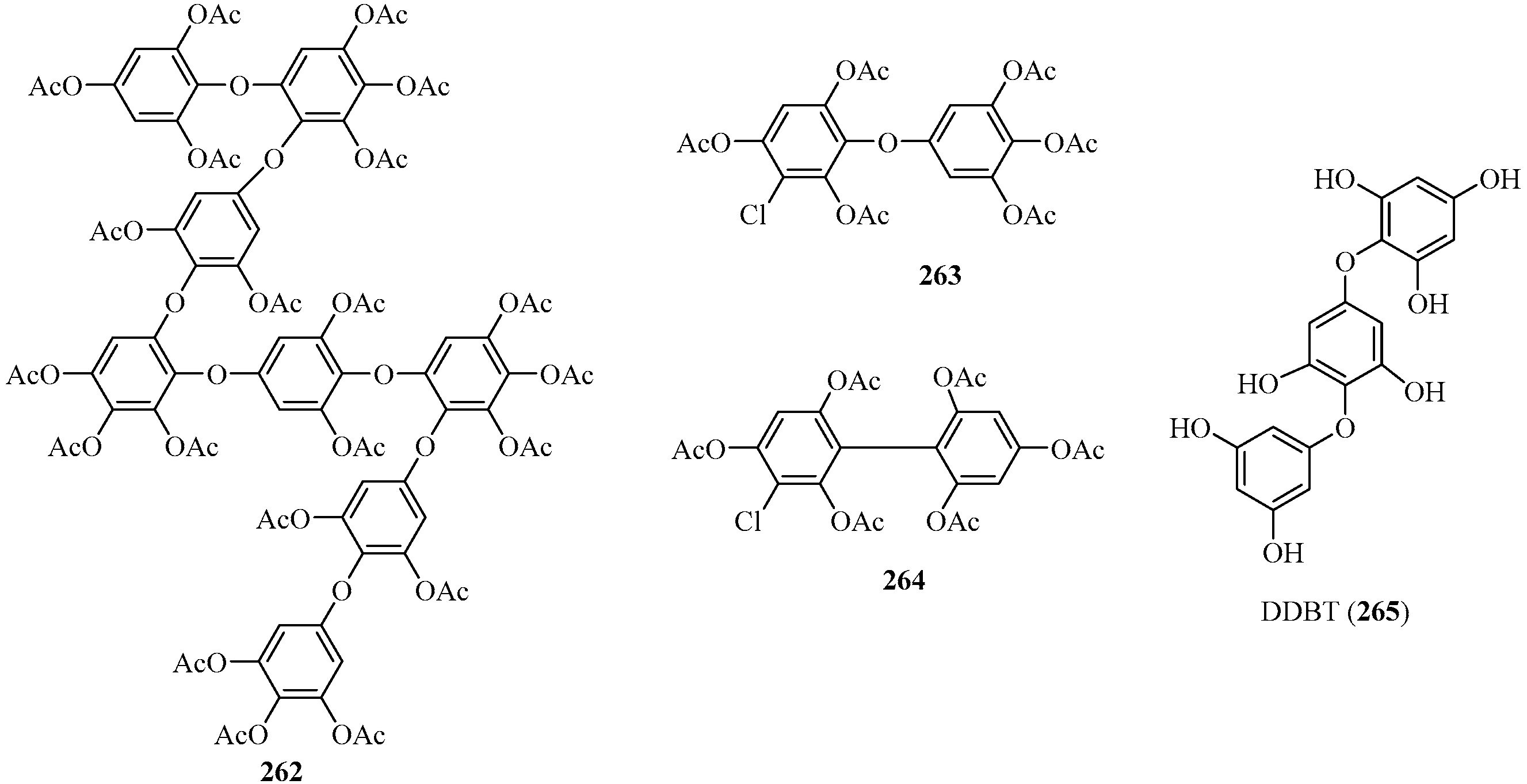
2.3. Steroids
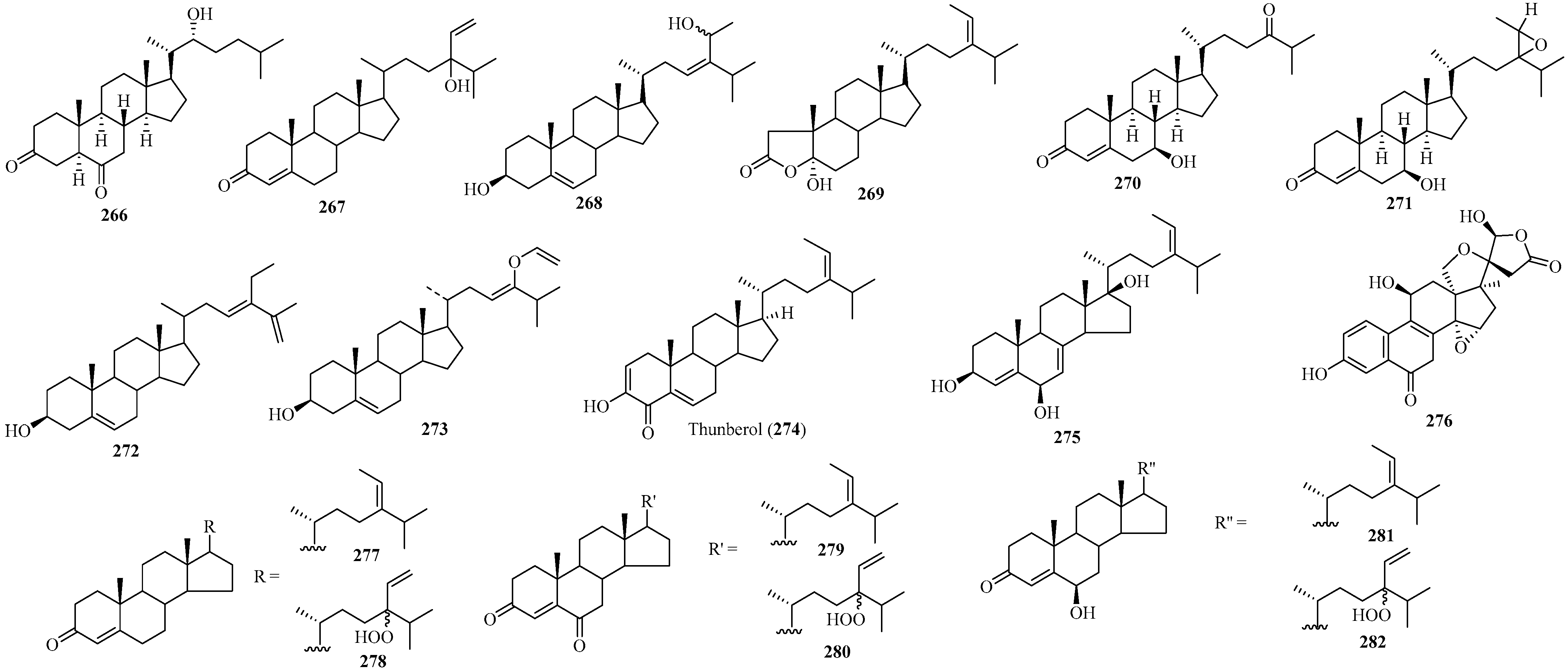
2.4. Others
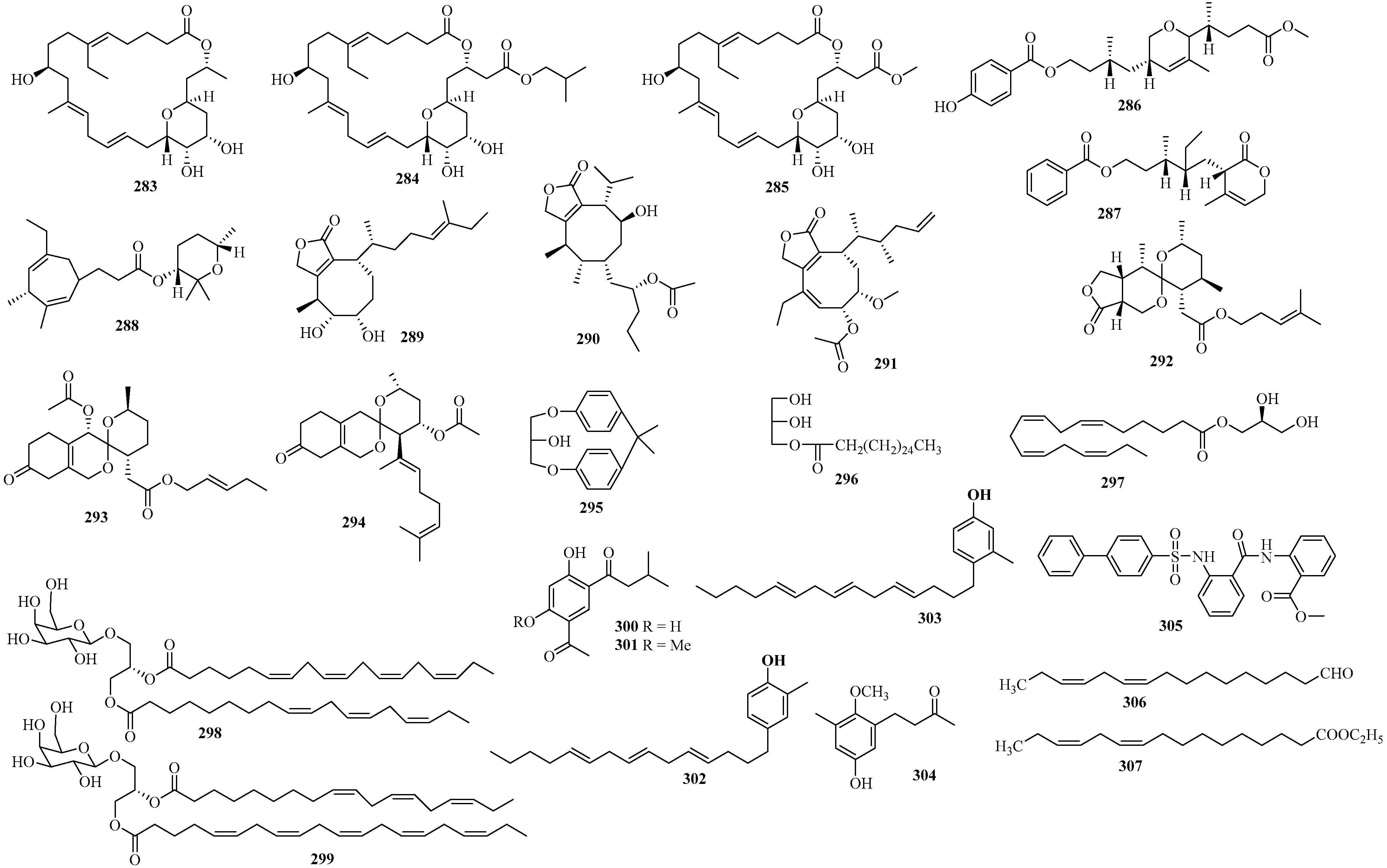
3. Conclusions
Author Contributions
Funding
Institutional Review Board Statement
Data Availability Statement
Acknowledgments
Conflicts of Interest
References
- Kumari, P.; Kumar, M.; Gupta, V.; Reddy, C.R.K.; Jha, B. Tropical marine macroalgae as potential sources of nutritionally important PUFAs. Food Chem. 2010, 120, 749–757. [Google Scholar] [CrossRef]
- Anis, M.; Ahmed, S.; Hasan, M.M. Algae as nutrition, medicine and cosmetic: The forgotten history, present status and future trends. World J. Pharm. Sci. 2017, 6, 1934–1959. [Google Scholar]
- Yende, S.R.; Harle, U.N.; Chaugule, B.B. Therapeutic potential and health benefits of Sargassum species. Phcog. Rev. 2014, 8, 1–7. [Google Scholar] [CrossRef] [PubMed]
- Muñoz, J.; Culioli, G.; Köck, M. Linear Diterpenes from the Marine Brown Alga Bifurcaria bifurcata: A chemical perspective. Phytochem. Rev. 2013, 12, 407–424. [Google Scholar] [CrossRef]
- Remya, R.R.; Samrot, A.V.; Kumar, S.S.; Mohanavel, V.; Karthick, A.; Chinnaiyan, V.K.; Umapathy, D.; Muhibbullah, M. Bioactive potential of brown algae. Adsorpt. Sci. Technol. 2022, 2022, 1–13. [Google Scholar] [CrossRef]
- Arrieche, D.; Carrasco, H.; Olea, A.F.; Espinoza, L.; San-Martín, A. Secondary metabolites isolated from Chilean Marine Algae: A Review. Mar. Drugs 2022, 20, 337. [Google Scholar] [CrossRef] [PubMed]
- Máximo, P.; Ferreira, L.M.; Branco, P.; Lima, P.; Lourenço, A. Secondary metabolites and biological activity of invasive macroalgae of Southern Europe. Mar. Drugs 2018, 16, 265. [Google Scholar] [CrossRef] [PubMed]
- Peng, Y.; Hu, J.; Yang, B.; Lin, X.P.; Zhou, X.F.; Yang, X.W.; Liu, Y.H. Chemical Composition of Seaweed. In Seaweed Sustainability: Food and Non-Food Applications, 1st ed.; Tiwari, B.K., Troy, D.J., Eds.; Academic Press: Amsterdam, The Netherlands, 2015; pp. 79–124. [Google Scholar]
- Balboa, E.M.; Conde, E.; Moure, A.; Falqué, E.; Domínguez, H. In vitro antioxidant properties of crude extracts and compounds from brown algae. Food Chem. 2013, 138, 1764–1785. [Google Scholar] [CrossRef]
- Generalić Mekinić, I.; Skroza, D.; Šimat, V.; Hamed, I.; Čagalj, M.; Popović Perković, Z. Phenolic content of brown algae (Pheophyceae) species: Extraction, identification, and quantification. Biomolecules 2019, 9, 244. [Google Scholar] [CrossRef]
- Huang, B.; Ding, L.; Luan, R.; Sun, Z. New classification system of marine brown algae of China. Guangxi Sci. 2015, 22, 189–200. [Google Scholar]
- Carroll, A.R.; Copp, B.R.; Davis, R.A.; Keyzers, R.A.; Prinsep, M.R. Marine natural products. Nat. Prod. Rep. 2022, 39, 1122–1171. [Google Scholar] [CrossRef] [PubMed]
- Blunt, J.W.; Carroll, A.R.; Copp, B.R.; Davis, R.A.; Keyzers, R.A.; Prinsep, M.R. Marine natural products. Nat. Prod. Rep. 2017, 34, 235–294. [Google Scholar] [CrossRef] [PubMed]
- Draisma, S.G.A.; Ballesteros, E.; Rousseau, F.; Thibaut, T. DNA sequence data demonstrate the polyphyly of the genus Cystoseira and other Sargassaceae genera (Phaeophyceae). J. Phycol. 2010, 46, 1329–1345. [Google Scholar] [CrossRef]
- Rousseau, F.; de Reviers, B. Phylogenetic relationships within the Fucales (Phaeophyceae) based on combined partial SSU + LSU rDNA sequence data. Eur. J. Phycol. 1999, 34, 53–64. [Google Scholar]
- Guiry, M.D.; Guiry, G.M. AlgaeBase. World-Wide Electronic Publication, National University of Ireland, Galway. Available online: http://www.algaebase.org (accessed on 7 August 2023).
- Liu, L.; Heinrich, M.; Myers, S.; Dworjanyn, S.A. Towards a better understanding of medicinal uses of the brown seaweed Sargassum in Traditional Chinese Medicine: A phytochemical and pharmacological review. J. Ethnopharmacol. 2012, 142, 591–619. [Google Scholar] [CrossRef] [PubMed]
- de Sousa, C.B.; Gangadhar, K.N.; Macridachis, J.; Pavão, M.; Morais, T.R.; Campino, L.; Varela, J.; Lago, J.H.G. Cystoseira algae (Fucaceae): Update on their chemical entities and biological activities. Tetrahedron: Asymmetry 2017, 28, 1486–1505. [Google Scholar] [CrossRef]
- Catarino, M.D.; Pires, S.M.G.; Silva, S.; Costa, F.; Braga, S.S.; Pinto, D.C.G.A.; Silva, A.M.S.; Cardoso, S.M. Overview of phlorotannins’ constituents in Fucales. Mar. Drugs 2022, 20, 754. [Google Scholar] [CrossRef]
- Valls, R.; Piovetti, L. The chemistry of the Cystoseiraceae (Fucales: Pheophyceae): Chemotaxonomic relationships. Biochem. Syst. Ecol. 1995, 23, 723–745. [Google Scholar] [CrossRef]
- Gouveia, V.; Seca, A.M.L.; Barreto, M.C.; Pinto, D.C.G.A. Di- and sesquiterpenoids from Cystoseira genus: Structure, intra-molecular transformations and biological activity. Mini-Rev. Med. Chem. 2013, 13, 1150–1159. [Google Scholar] [CrossRef]
- Chen, Z.; Liu, H.B. Recent Advance on the Chemistry and Bioactivity of Genus Sargassum. Chin. J. Mar. Drugs 2012, 31, 41–51. [Google Scholar]
- Rushdi, M.I.; Abdel-Rahman, I.A.M.; Saber, H.; Attia, E.Z.; Abdelraheem, W.M.; Madkour, H.A.; Hassan, H.M.; Elmaidomy, A.H. Pharmacological and natural products diversity of the brown algae genus Sargassum. RSC Adv. 2020, 10, 24951–24972. [Google Scholar] [CrossRef] [PubMed]
- Rushdi, M.I.; Abdel-Rahman, I.A.M.; Saber, H.; Attia, E.Z.; Abdelraheem, W.M.; Madkour, H.A.; Abdelmohsen, U.R. The genus Turbinaria: Chemical and pharmacological diversity. Nat. Prod. Res. 2021, 35, 4560–4578. [Google Scholar] [CrossRef] [PubMed]
- Xu, R.S.; Ye, Y.; Zhao, W.M. Natural Products Chemistry, 2nd ed.; Beijing Press: Beijing, China, 2004; pp. 166–374. [Google Scholar]
- Roberts, S.C. Production and engineering of terpenoids in plant cell culture. Nat. Chem. Biol. 2007, 3, 387–395. [Google Scholar] [CrossRef] [PubMed]
- Salem, A.B.; Di Giuseppe, G.; Anesi, A.; Hammami, S.; Mighri, Z.; Guella, G. Natural products among brown algae: The case of Cystoseira schiffneri Hamel (Sargassaceae, Phaeophyceae). Chem. Biodivers. 2017, 14, e1600333. [Google Scholar] [CrossRef] [PubMed]
- Peng, Y.; Huang, R.M.; Lin, X.P.; Liu, Y.H. Norisoprenoids from the brown alga Sargassum naozhouense Tseng et Lu. Molecules 2018, 23, 348. [Google Scholar] [CrossRef]
- Smith, A.B.; Branca, S.J.; Pilla, N.N.; Guaciaro, M.A. Stereocontrolled total synthesis of (±)-pentenomycins. I-III, their epimers, and dehydropentenomycin I. J. Org. Chem. 1982, 47, 1855–1869. [Google Scholar] [CrossRef]
- Kimura, J.; Maki, N. New loliolide derivatives from the brown alga Undaria pinnatifa. J. Nat. Prod. 2002, 65, 57–58. [Google Scholar] [CrossRef] [PubMed]
- Fattorusso, E.; Magno, S.; Mayol, L.; Santacroce, C.; Sica, D.; Amico, V.; Oriente, G.; Piattelli, M.; Tringal, C. Oxocrinol and Crinitol, novel linear terpenoids from the brown alga Cystoseira crinita. Tetrahedron Lett. 1976, 17, 937–940. [Google Scholar] [CrossRef]
- Takada, N.; Watanabe, R.; Suenaga, K.; Yamada, K.; Uemura, D. Isolation and structures of hedaols A, B, and C, new bisnorditerpenes from a Japanese brown alga. J. Nat. Prod. 2001, 64, 653–655. [Google Scholar] [CrossRef]
- Kusumi, T.; Ishitsuka, M.; Nomura, Y.; Konno, T.; Kakisawa, H. New farnesylacetone derivatives from Sargassum micracanthum. Chem. Lett. 1979, 8, 1181–1184. [Google Scholar] [CrossRef]
- Shizuri, Y.; Matsukawa, S.; Ojika, M.; Yamada, K. Two new farnesylacetone derivatives from the brown alga Sargassum micracanthum. Phytochemistry 1982, 21, 1808–1809. [Google Scholar] [CrossRef]
- Reddy, P.; Urban, S. Linear and cyclic C18 terpenoids from the Southern Australian marine brown alga Cystophora moniliformis. J. Nat. Prod. 2008, 71, 1441–1446. [Google Scholar] [CrossRef] [PubMed]
- Valls, R.; Banaigs, B.; Francisco, C.; Codomier, L.; Cave, A. An acyclic diterpene from the brown alga Bifurcaria bifurcata. Phytochemistry 1986, 25, 751–752. [Google Scholar] [CrossRef]
- Culioli, G.; Ortalo-Magné, A.; Daoudi, M.; Thomas-Guyon, H.; Valls, R.; Piovetti, L. Trihydroxylated linear diterpenes from the brown alga Bifurcaria bifurcata. Phytochemistry 2004, 65, 2063–2069. [Google Scholar] [CrossRef]
- El Hattab, M.; Ben Mesaoud, M.; Daoudi, M.; Ortalo-Magné, A.; Culioli, G.; Valls, R.; Piovetti, L. Trihydroxylated linear diterpenes from the brown alga Bifurcaria bifurcata (Fucales, Phaeophyta). Biochem. Syst. Ecol. 2008, 36, 484–489. [Google Scholar] [CrossRef]
- Culioli, G.; Daoudi, M.; Ortalo-Magné, A.; Valls, R.; Piovetti, L. (S)-12-hydroxygeranylgeraniol-derived diterpenes from the brown alga Bifurcaria bifurcata. Phytochemistry 2001, 57, 529–535. [Google Scholar] [CrossRef] [PubMed]
- Semmak, L.; Zerzouf, A.; Valls, R.; Banaigs, B.; Jeanty, G.; Francisco, C. Acyclic diterpenes from Bifurcaria bifurcata. Phytochemistry 1988, 27, 2347–2349. [Google Scholar] [CrossRef]
- Valls, R.; Piovetti, L.; Banaigs, B.; Archavlis, A.; Pellegrini, M. (S)-13-hydroxygeranylgeraniol-derived furanoditerpenes from Bifurcaria bifurcata. Phytochemistry 1995, 39, 145–149. [Google Scholar] [CrossRef]
- Smyrniotopoulos, V.; Merten, C.; Kaiser, M.; Tasdemir, D. Bifurcatriol, a new antiprotozoal acyclic diterpene from the brown alga Bifurcaria bifurcata. Mar. Drugs 2017, 15, 245. [Google Scholar] [CrossRef]
- Smyrniotopoulos, V.; Firsova, D.; Fearnhead, H.; Grauso, L. Density functional theory (DFT)-aided structure elucidation of linear diterpenes from the Irish brown seaweed Bifurcaria bifurcata. Mar. Drugs 2021, 19, 42. [Google Scholar] [CrossRef]
- Smyrniotopoulos, V.; Merten, C.; Firsova, D.; Fearnhead, H.; Tasdemir, D. Oxygenated acyclic diterpenes with anticancer activity from the Irish brown seaweed Bifurcaria bifurcata. Mar. Drugs 2020, 18, 581. [Google Scholar] [CrossRef] [PubMed]
- Ortalo-Magné, A.; Culioli, G.; Valls, R.; Pucci, B.; Piovetti, L. Polar acyclic diterpenoids from Bifurcaria bifurcata. Phytochemistry 2005, 66, 2316–2323. [Google Scholar] [CrossRef] [PubMed]
- Amico, V.; Oriente, G.; Piattelli, M.; Ruberto, G.; Tringali, C. Novel acyclic diterpenes from the brown alga Cystoseira crinita. Phytochemistry 1981, 20, 1085–1088. [Google Scholar] [CrossRef]
- Combaut, G.; Piovetti, L. A novel acyclic diterpene from the brown alga Bifurcaria bifurcata. Phytochemistry 1983, 22, 1787–1789. [Google Scholar] [CrossRef]
- Göthel, Q.; Muñoz, J.; Köck, M. Formyleleganolone and bibifuran, two metabolites from the brown alga Bifurcaria bifurcata. Phytochem. Lett. 2012, 5, 693–695. [Google Scholar] [CrossRef]
- Göthel, Q.; Lichte, E.; Köck, M. Further eleganolone-derived diterpenes from the brown alga Bifurcaria bifurcata. Tetrahedron Lett. 2012, 53, 1873–1877. [Google Scholar] [CrossRef]
- Hougaard, L.; Anthoni, U.; Christophersen, C. Two new diterpenoid dihydroxy-γ-butyrolactones from Bifurcaria bifurcata (Cystoseiraceae). Tetrahedron Lett. 1991, 32, 3577–3578. [Google Scholar] [CrossRef]
- Valls, R.; Banaigs, B.; Piovetti, L.; Archavlis, A.; Artaud, J. Linear diterpene with antimitotic activity from the brown alga Bifurcaria bifurcata. Phytochemistry 1993, 34, 1585–1588. [Google Scholar] [CrossRef]
- Ayyad, S.E.N.; Abdel-Halim, O.B.; Shier, W.T.; Hoye, T.R. Cytotoxic hydroazulene diterpenes from the brown alga Cystoseira myrica. Z. Naturforsch. C 2003, 58, 33–38. [Google Scholar] [CrossRef]
- Dhara, S.; Chakraborty, K. Anti-inflammatory xenicane-type diterpenoid from the intertidal brown seaweed Sargassum ilicifolium. Nat. Prod. Res. 2021, 35, 5699–5709. [Google Scholar] [CrossRef]
- Thambi, A.; Chakraborty, K. Anti-inflammatory decurrencyclics A-B, two undescribed nor-dammarane triterpenes from triangular sea bell Turbinaria decurrens. Nat. Prod. Res. 2023, 37, 713–724. [Google Scholar] [CrossRef] [PubMed]
- Joung, E.-J.; Gwon, W.-G.; Shin, T.; Jung, B.-M.; Choi, J.; Kim, H.-R. Anti-inflammatory action of the ethanolic extract from Sargassum serratifolium on lipopolysaccharide-stimulated mouse peritoneal macrophages and identification of active components. J. Appl. Phycol. 2017, 29, 563–573. [Google Scholar] [CrossRef]
- Azam, M.S.; Choi, J.; Lee, M.-S.; Kim, H.-R. Hypopigmenting effects of brown algae-derived phytochemicals: A review on molecular mechanisms. Mar. Drugs 2017, 15, 297. [Google Scholar] [CrossRef] [PubMed]
- Fisch, K.M.; Böhm, V.; Wright, A.D.; König, G.M. Antioxidative meroterpenoids from the brown alga Cystoseira crinita. J. Nat. Prod. 2003, 66, 968–975. [Google Scholar] [CrossRef] [PubMed]
- Praud, A.; Valls, R.; Piovetti, L.; Banaigs, B.; BenaΪm, J.-Y. Meroditerpenes from the brown alga Cystoseira crinita off the French Mediterranean coast. Phytochemistry 1995, 40, 495–500. [Google Scholar] [CrossRef]
- Gouveia, V.L.M.; Seca, A.M.L.; Barreto, M.C.; Neto, A.I.; Kijjoa, A.; Silva, A.M.S. Cytotoxic meroterpenoids from the macroalga Cystoseira abies-marina. Phytochem. Lett. 2013, 6, 593–597. [Google Scholar] [CrossRef]
- Fernández, J.J.; Navarro, G.; Norte, M. Novel metabolites from the brown alga Cystoseira abies-marina. Nat. Prod. Lett. 1998, 12, 285–291. [Google Scholar] [CrossRef]
- García, P.A.; Hernández, Á.P.; San Feliciano, A.; Castro, M.Á. Bioactive prenyl- and terpenyl-quinones/hydroquinones of marine origin. Mar. Drugs 2018, 16, 292. [Google Scholar] [CrossRef]
- Mesguiche, V.; Valls, R.; Piovetti, L.; Banaigs, B. Meroditerpenes from Cystoseira amentacea var. stricta collected off the Mediterranean coasts. Phytochemistry 1997, 45, 1489–1494. [Google Scholar]
- Mokrini, R.; Mesaoud, M.B.; Daoudi, M.; Hellio, C.; Maréchal, J.-P.; El Hattab, M.; Ortalo-Magné, A.; Piovetti, L.; Culioli, G. Meroditerpenoids and derivatives from the brown alga Cystoseira baccata and their antifouling properties. J. Nat. Prod. 2008, 71, 1806–1811. [Google Scholar] [CrossRef]
- Navarro, G.; Fernández, J.J.; Norte, M. Novel meroditerpenes from the brown alga Cystoseira sp. J. Nat. Prod. 2004, 67, 495–499. [Google Scholar] [CrossRef] [PubMed]
- Amico, V. Marine brown algae of family Cystoseiraceae: Chemistry and chemotaxonomy. Phytochemistry 1995, 39, 1257–1279. [Google Scholar] [CrossRef]
- Amico, V.; Cunsolo, F.; Piattelli, M.; Ruberto, G.; Fronczek, F.R. Balearone, a metabolite of the brown alga Cystoseira balearica. Tetrahedron 1984, 40, 1721–1725. [Google Scholar] [CrossRef]
- Amico, V.; Piattelli, M.; Neri, P.; Ruberto, G.; Mayol, L. Novel metabolites from the marine genus cystoseira-application of two-dimensional 1H-13C correlation to the structure elucidation. Tetrahedron 1986, 42, 6015–6020. [Google Scholar] [CrossRef]
- Amico, V.; Cunsolo, F.; Piattelli, M.; Ruberto, G. Prenylated O-methyltoluquinols from Cystoseira stricta. Phytochemistry 1987, 26, 1719–1722. [Google Scholar] [CrossRef]
- Amico, V.; Oriente, G.; Piattelli, M.; Ruberto, G.; Tringali, C. A quinone-hydroquinone couple from the brown alga Cystoseira stricta. Phytochemistry 1982, 21, 421–424. [Google Scholar] [CrossRef]
- Amico, V.; Cunsolo, F.; Piattelli, M.; Ruberto, G.; Mayol, L. Strictaketal, a new tetraprenyltoluquinol with a heterotetracyclic diterpene moiety from the brown alga Cystoseira stricta. J. Nat. Prod. 1987, 50, 449–454. [Google Scholar] [CrossRef]
- Amico, V.; Oriente, G.; Neri, P.; Piattelli, M.; Ruberto, G. Tetraprenyltoluquinols from the brown alga Cystoseira stricta. Phytochemistry 1987, 26, 1715–1718. [Google Scholar] [CrossRef]
- Amico, V.; Piattelli, M.; Cunsolo, F.; Neri, P.; Ruberto, G. Two epimeric, irregular diterpenoid toluquinols from the brown alga Cystoseira stricta. J. Nat. Prod. 1989, 52, 962–969. [Google Scholar] [CrossRef]
- El Hattab, M.; Genta-Jouve, G.; Bouzidi, N.; Ortalo-Magné, A.; Hellio, C.; Maréchal, J.-P.; Piovetti, L.; Thomas, O.P.; Culioli, G. Cystophloroketals A-E, unusual phloroglucinol-meroterpenoid hybrids from the brown alga Cystoseira tamariscifolia. J. Nat. Prod. 2015, 78, 1663–1670. [Google Scholar] [CrossRef]
- de los Reyes, C.; Zbakh, H.; Motilva, V.; Zubía, E. Antioxidant and anti-inflammatory meroterpenoids from the brown alga Cystoseira usneoides. J. Nat. Prod. 2013, 76, 621–629. [Google Scholar] [CrossRef] [PubMed]
- de los Reyes, C.; Ortega, M.J.; Zbakh, H.; Motilva, V.; Zubía, E. Cystoseira usneoides: A brown alga rich in antioxidant and anti-inflammatory meroditerpenoids. J. Nat. Prod. 2016, 79, 395–405. [Google Scholar] [CrossRef]
- Urones, J.G.; Basabe, P.; Marcos, I.S.; Pineda, J.; Lithgow, A.M.; Moro, R.F.; Palma, F.M.S.B.; Araújo, M.E.M.; Gravalos, M.D.G. Meroterpenes from Cystoseira usneoides. Phytochemistry 1992, 31, 179–182. [Google Scholar] [CrossRef]
- Urones, J.G.; Araujo, M.E.M.; Palma, F.M.S.B.; Basabe, P.; Marcos, I.S.; Moro, R.F.; Lithgow, A.M.; Pineda, J. Meroterpenes from Cystoseira usneoides II. Phytochemistry 1992, 31, 2105–2109. [Google Scholar] [CrossRef]
- Amico, V.; Cunsolo, F.; Piattelli, M.; Ruberto, G. Acyclic tetraprenyltoluquinols from Cystoseira sauvageuana and their possible role as biogenetic precursors of the cyclic Cystoseira metabolites. Phytochemistry 1985, 24, 2663–2668. [Google Scholar] [CrossRef]
- Laird, D.W.; Poole, R.; Wikström, M.; van Altena, I.A. Pycnanthuquinone C, an unusual 6,6,5-tricyclic geranyltoluquinone from the Western Australian brown alga Cystophora harveyi. J. Nat. Prod. 2007, 70, 671–674. [Google Scholar] [CrossRef] [PubMed]
- Reddy, P.; Urban, S. Meroditerpenoids from the southern Australian marine brown alga Sargassum fallax. Phytochemistry 2009, 70, 250–255. [Google Scholar] [CrossRef]
- Niwa, H.; Kurimoto, S.; Kubota, T.; Sekiguchi, M. Macrocarquinoids A–C, new meroterpenoids from Sargassum macrocarpum. J. Nat. Med. 2021, 75, 194–200. [Google Scholar] [CrossRef]
- Mori, J.; Iwashima, M.; Wakasugi, H.; Saito, H.; Matsunaga, T.; Ogasawara, M.; Takahashi, S.; Suzuki, H.; Hayashi, T. New plastoquinones isolated from the brown alga, Sargassum micracanthum. Chem. Pharm. Bull. 2005, 53, 1159–1163. [Google Scholar] [CrossRef]
- Brkljača, R.; Urban, S. Chemical profiling (HPLC-NMR & HPLC-MS), isolation, and identification of bioactive meroditerpenoids from the southern Australian marine brown alga Sargassum paradoxum. Mar. Drugs 2015, 13, 102–127. [Google Scholar]
- Horie, S.; Tsutsumi, S.; Takada, Y.; Kimura, J. Antibacterial quinone metabolites from the brown alga, Sargassum sagamianum. Bull. Chem. Soc. Jpn. 2008, 81, 1125–1130. [Google Scholar] [CrossRef]
- Segawa, M.; Shirahama, H. New plastoquinones from the brown alga Sargassum sagamianum var. yezoense. Chem. Lett. 1987, 16, 1365–1366. [Google Scholar] [CrossRef]
- Jung, M.; Jang, K.H.; Kim, B.; Lee, B.H.; Choi, B.W.; Oh, K.-B.; Shin, H. Meroditerpenoids from the brown alga Sargassum siliquastrum. J. Nat. Prod. 2008, 71, 1714–1719. [Google Scholar] [CrossRef] [PubMed]
- Ishitsuka, M.; Kusumi, T.; Nomura, Y.; Konno, T.; Kakisawa, H. New geranylgeranylbenzoquinone derivatives from Sargassum tortile. Chem. Lett. 1979, 8, 1269–1272. [Google Scholar] [CrossRef]
- Valls, R.; Piovetti, L.; Banaigs, B.; Praud, A. Secondary metabolites from Morocco brown algae of the genus Cystoseira. Phytochemistry 1993, 32, 961–966. [Google Scholar] [CrossRef]
- Fuentes-Monteverde, J.C.C.; Nath, N.; Forero, A.M.; Balboa, E.M.; Navarro-Vázquez, A.; Griesinger, C.; Jiménez, C.; Rodríguez, J. Connection of isolated stereoclusters by combining 13C-RCSA, RDC, and J-based configurational analyses and structural revision of a tetraprenyltoluquinol chromane meroterpenoid from Sargassum muticum. Mar. Drugs 2022, 20, 462. [Google Scholar] [CrossRef]
- Balboa, E.M.; Li, Y.-X.; Ahn, B.-N.; Eom, S.-H.; Domínguez, H.; Jiménez, C.; Rodríguez, J. Photodamage attenuation effect by a tetraprenyltoluquinol chromane meroterpenoid isolated from Sargassum muticum. J. Photochem. Photobiol. B. 2015, 148, 51–58. [Google Scholar] [CrossRef]
- Iwashima, M.; Tako, N.; Hayakawa, T.; Matsunaga, T.; Mori, J.; Saito, H. New chromane derivatives isolated from the brown alga, Sargassum micracanthum. Chem. Pharm. Bull. 2008, 56, 124–128. [Google Scholar] [CrossRef]
- Cho, S.H.; Cho, J.Y.; Kang, S.E.; Hong, Y.K.; Ahn, D.H. Antioxidant activity of mojabanchromanol, a novel chromene, isolated from brown alga Sargassum siliquastrum. J. Environ. Biol. 2008, 29, 479–484. [Google Scholar]
- Lee, J.I.; Seo, Y. Chromanols from Sargassum siliquastrum and their antioxidant activity in HT1080 cells. Chem. Pharm. Bull. 2011, 59, 757–761. [Google Scholar] [CrossRef]
- Jang, K.H.; Lee, B.H.; Choi, B.W.; Lee, H.S.; Shin, J. Chromenes from the brown alga Sargassum siliquastrum. J. Nat. Prod. 2005, 68, 716–723. [Google Scholar] [CrossRef] [PubMed]
- Lee, J.-I.; Park, B.J.; Kim, H.; Seo, Y. Isolation of two new meroterpenoids from Sargassum siliquastrum. Bull. Korean. Chem. Soc. 2014, 35, 2867–2869. [Google Scholar] [CrossRef]
- Kang, H.-S.; Kim, J.-P. New chromene derivatives with radical scavenging activities from the brown alga Sargassum siliquastrum. J. Chem. Res. 2017, 41, 116–119. [Google Scholar] [CrossRef]
- Dhara, S.; Chakraborty, K. Novel furanyl-substituted isochromanyl class of anti-inflammatory turbinochromanone from brown seaweed Turbinaria conoides. Chem. Biodivers. 2022, 19, e202100723. [Google Scholar] [CrossRef] [PubMed]
- Seo, Y.; Park, K.E.; Kim, Y.A.; Lee, H.-J.; Yoo, J.-S.; Ahn, J.-W.; Lee, B.-J. Isolation of tetraprenyltoluquinols from the brown alga Sargassum thunbergii. Chem. Pharm. Bull. 2006, 54, 1730–1733. [Google Scholar] [CrossRef] [PubMed]
- Numata, A.; Kanbara, S.; Takahashi, C.; Fujiki, R.; Yoneda, M.; Usami, Y.; Fujita, E. A cytotoxic principle of the brown alga Sargassum tortile and structures of chromenes. Phytochemistry 1992, 31, 1209–1213. [Google Scholar] [CrossRef]
- Kikuchi, T.; Mori, Y.; Yokoi, T.; Nakazawa, S.; Kuroda, H.; Masada, Y.; Kitamura, K.; Umezaki, I. Structure of sargatriol, a new isoprenoid chromenol from a marine alga: Sargassum tortile. Chem. Pharm. Bull. 1975, 23, 690–692. [Google Scholar] [CrossRef]
- Kikuchi, T.; Mori, Y.; Yokoi, T.; Nakazawa, S.; Kuroda, H.; Masada, Y.; Kitamura, K.; Kuriyama, K. Structure and absolute configuration of sargatriol, a new isoprenoid chromenol from a brown alga, Sargassum tortile C. Agardh. Chem. Pharm. Bull. 1983, 31, 106–113. [Google Scholar] [CrossRef]
- Jung, M.; Jang, K.H.; Kim, B.; Lee, B.H.; Choi, B.W.; Oh, K.-B.; Shin, H. Meroditerpenoids from the brown alga Sargassum siliquastrum. J. Nat. Prod. 2009, 72, 1723. [Google Scholar] [CrossRef]
- Gunathilake, T.; Akanbi, T.O.; Suleria, H.A.R.; Nalder, T.D.; Francis, D.S.; Barrow, C.J. Seaweed phenolics as natural antioxidants, aquafeed additives, veterinary treatments and cross-linkers for microencapsulation. Mar. Drugs 2022, 20, 445. [Google Scholar] [CrossRef]
- Singh, I.P.; Bharate, S.B. Phloroglucinol compounds of natural origin. Nat. Prod. Rep. 2006, 23, 558–591. [Google Scholar] [CrossRef] [PubMed]
- Jiang, C.-S.; Wang, Y.-Y.; Song, J.-T.; Yu, J.-H. Acylphloroglucinols as kinase inhibitors from Sargassum nigrifoloides. J. Asian Nat. Prod. Res. 2018, 21, 619–626. [Google Scholar] [CrossRef] [PubMed]
- Kim, C.; Lee, I.-K.; Cho, G.Y.; Oh, K.-H.; Lim, Y.W.; Yun, B.-S. Sargassumol, a novel antioxidant from the brown alga Sargassum micracanthum. J. Antibiot. 2012, 65, 87–89. [Google Scholar] [CrossRef] [PubMed]
- Keusgen, M.; Falk, M.; Walter, J.A.; Glombitza, K.-W. A phloroglucinol derivative from brown alga Sargassum spinuligerum. Phytochemistry 1997, 46, 1–8. [Google Scholar] [CrossRef]
- Glombitza, K.-W.; Li, S.-M. Fucophlorethols from the brown alga Carpophyllum maschalocarpum. Phytochemistry 1991, 30, 3423–3427. [Google Scholar] [CrossRef]
- Glombitza, K.-M.; Keusgen, M.; Hauperich, S. Fucophlorethols from the brown algae Sargassum spinuligerum and Cystophora torulosa. Phytochemistry 1997, 46, 1417–1422. [Google Scholar] [CrossRef]
- Glombitza, K.-W.; Hauperich, S. Phlorotannins from the brown alga Cystophora torulosa. Phytochemistry 1997, 46, 735–740. [Google Scholar] [CrossRef]
- Glombitza, K.-M.; Hauperich, S.; Keusgen, M. Phlorotannins from the brown algae Cystophora torulosa and Sargassum spinuligerum. Nat. Toxins 1997, 5, 58–63. [Google Scholar] [CrossRef]
- Glombitza, K.-W.; Li, S.-M. Hydroxyphlorethols from the brown alga Carpophyllum maschalocarpum. Phytochemistry 1991, 30, 2741–2745. [Google Scholar] [CrossRef]
- Glombitza, K.-M.; Schmidt, A. Trihydroxyphlorethols from the brown alga Carpophyllum angustifolium. Phytochemistry 1999, 51, 1095–1100. [Google Scholar] [CrossRef]
- Li, S.-M.; Glombitza, K.-W. Carmalols and phlorethofuhalols from the brown alga Carpophyllum maschalocarpum. Phytochemistry 1991, 30, 3417–3421. [Google Scholar] [CrossRef]
- Glombitza, K.-W.; Schmidt, A. Nonhalogenated and halogenated phlorotannins from the brown alga Carpophyllum angustifolium. J. Nat. Prod. 1999, 62, 1238–1240. [Google Scholar] [CrossRef] [PubMed]
- Kawamura-Konishi, Y.; Watanabe, N.; Saito, M.; Nakajima, N.; Sakaki, T.; Katayama, T.; Enomoto, T. Isolation of a new phlorotannin, a potent inhibitor of carbohydrate-hydrolyzing enzymes, from the brown alga Sargassum patens. J. Agric. Food Chem. 2012, 60, 5565–5570. [Google Scholar] [CrossRef] [PubMed]
- Hamdy, A.-H.A.; Aboutabl, E.A.; Sameer, S.; Hussein, A.A.; Díaz-Marrero, A.R.; Darias, J.; Cueto, M. 3-Keto-22-epi-28-nor-cathasterone, a brassinosteroid-related metabolite from Cystoseira myrica. Steroids 2009, 74, 927–930. [Google Scholar] [CrossRef]
- Ayyad, S.-E.N.; Sowellim, S.Z.A.; El-Hosini, M.S.; Abo-Atia, A. The structural determination of a new steroidal metabolite from the brown alga Sargassum asperifolium. Z. Naturforsch. C. 2003, 58, 5–6. [Google Scholar] [CrossRef]
- Tang, H.-F.; Yi, Y.-H.; Yao, X.-S.; Xu, Q.-Z.; Zhang, S.-Y.; Lin, H.-W. Bioactive steroids from the brown alga Sargassum carpophyllum. J. Asian Nat. Prod. Res. 2002, 4, 95–101. [Google Scholar] [CrossRef]
- Wang, S.-Y.; Xiang, J.; Huang, X.-J.; Wei, X.; Zhang, Q.; Du, X.-H.; Hu, J.-S.; Wang, Y.-M.; Zhang, C.-X. Chemical constituents from Sargassum fusiforme (Harv.) Setch. Chem. Biodivers. 2020, 17, e2000182. [Google Scholar] [CrossRef]
- Xu, S.-H.; Ding, L.-S.; Wang, M.-K.; Peng, S.-L.; Liao, X. Studies on the chemical constituents of the algae Sargassum polycystcum. Chin. J. Org. Chem. 2002, 22, 138–140. [Google Scholar]
- Kobayashi, M.; Hasegawa, A.; Mitsuhashi, H. Marine sterols. XV. Isolation of 24-vinyloxycholesta-5,23-dien-3β-ol from the brown alga Sargassum thumbergii. Chem. Pharm. Bull. 1985, 33, 4012–4013. [Google Scholar] [CrossRef]
- He, W.-F.; Yao, L.-G.; Liu, H.-L.; Guo, Y.-W. Thunberol, a new sterol from the Chinese brown alga Sargassum thunbergii. J. Asian Nat. Prod. Res. 2014, 16, 685–689. [Google Scholar] [CrossRef]
- Kumar, S.S.; Kumar, Y.K.; Khan, M.S.Y.; Gupta, V. New antifungal steroids from Turbinaria conoides (J.Agardh) Kutzing. Nat. Prod. Res. 2010, 24, 1481–1487. [Google Scholar] [CrossRef] [PubMed]
- Sheu, J.-H.; Wang, G.-H.; Sung, P.-J.; Duh, C.-Y. New cytotoxic oxygenated fucosterols from the brown alga Turbinaria conoides. J. Nat. Prod. 1999, 62, 224–227. [Google Scholar] [CrossRef] [PubMed]
- Chakraborty, K.; Dhara, S. Conoidecyclics A-C from marine macroagla Turbinaria conoides: Newly described natural macrolides with prospective bioactive properties. Phytochemistry 2021, 191, 112909. [Google Scholar] [CrossRef] [PubMed]
- Chakraborty, K.; Dhara, S. First report of substituted 2H-pyranoids from brown seaweed Turbinaria conoides with antioxidant and anti-inflammatory activities. Nat. Prod. Res. 2020, 34, 3451–3461. [Google Scholar] [CrossRef] [PubMed]
- Dhara, S.; Chakraborty, K. Turbinafuranone A–C, new 2-furanone analogures from marine macroalga Turbinaria ornata as prospective anti-hyperglycemic agents attenuate tyrosine phosphatase-1B. Med. Chem. Res. 2021, 30, 1635–1648. [Google Scholar] [CrossRef]
- Chakraborty, K.; Dhara, S. Spirornatas A–C from brown alga Turbinaria ornata: Anti-hypertensive spiroketals attenuate angiotensin-I converting enzyme. Phytochemistry 2022, 195, 113024. [Google Scholar] [CrossRef]
- Qi, S.-H.; Zhang, S.; Huang, J.-S.; Xiao, Z.-H.; Wu, J.; Long, L.-J. Glycerol derivatives and sterols from Sargassum parvivesiculosum. Chem. Pharm. Bull. 2004, 52, 986–988. [Google Scholar] [CrossRef]
- Chang, H.W.; Jang, K.H.; Lee, D.; Kang, H.R.; Kim, T.-Y.; Lee, B.H.; Choi, B.W.; Kim, S.; Shin, J. Monoglycerides from the brown alga Sargassum sagamianum: Isolation, synthesis, and biological activity. Bioorg. Med. Chem. Lett. 2008, 18, 3589–3592. [Google Scholar] [CrossRef]
- Kim, Y.H.; Kim, E.-H.; Lee, C.; Kim, M.-H.; Rho, J.-R. Two new monogalactosyl diacylglycerols from brown alga Sargassum thunbergii. Lipids 2007, 42, 395–399. [Google Scholar] [CrossRef]
- Cai, Y.-P.; Xie, C.-B.; Wang, B.-C.; Li, P.-L.; Li, B.-F. Two new resorcinols from Sargassum thunbergii. J. Asian Nat. Prod. Res. 2010, 12, 1001–1104. [Google Scholar] [CrossRef]
- Alzarea, S.I.; Elmaidomy, A.H.; Saber, H.; Musa, A.; Al-Sanea, M.M.; Mostafa, E.M.; Hendawy, O.M.; Youssif, K.A.; Alanazi, A.S.; Alharbi, M.; et al. Potential anticancer lipoxygenase inhibitors from the Red Sea-derived brown algae Sargassum cinereum: An in-silico-supported in-vitro study. Antibiotics 2021, 10, 416. [Google Scholar] [CrossRef] [PubMed]
- Peng, Y.; Cao, L.; Liu, Y.; Huang, R. Sargassulfamide A, an unprecedented amide derivative from the seaweed Sargassum naozhouense. Chem. Nat. Compd. 2020, 56, 98–100. [Google Scholar] [CrossRef]
- Banaigs, B.; Francisco, C.; Gonzalez, E.; Codomier, L. Lipids from the brown alga Cystoseira barbata. Phytochemistry 1984, 23, 2951–2952. [Google Scholar] [CrossRef]



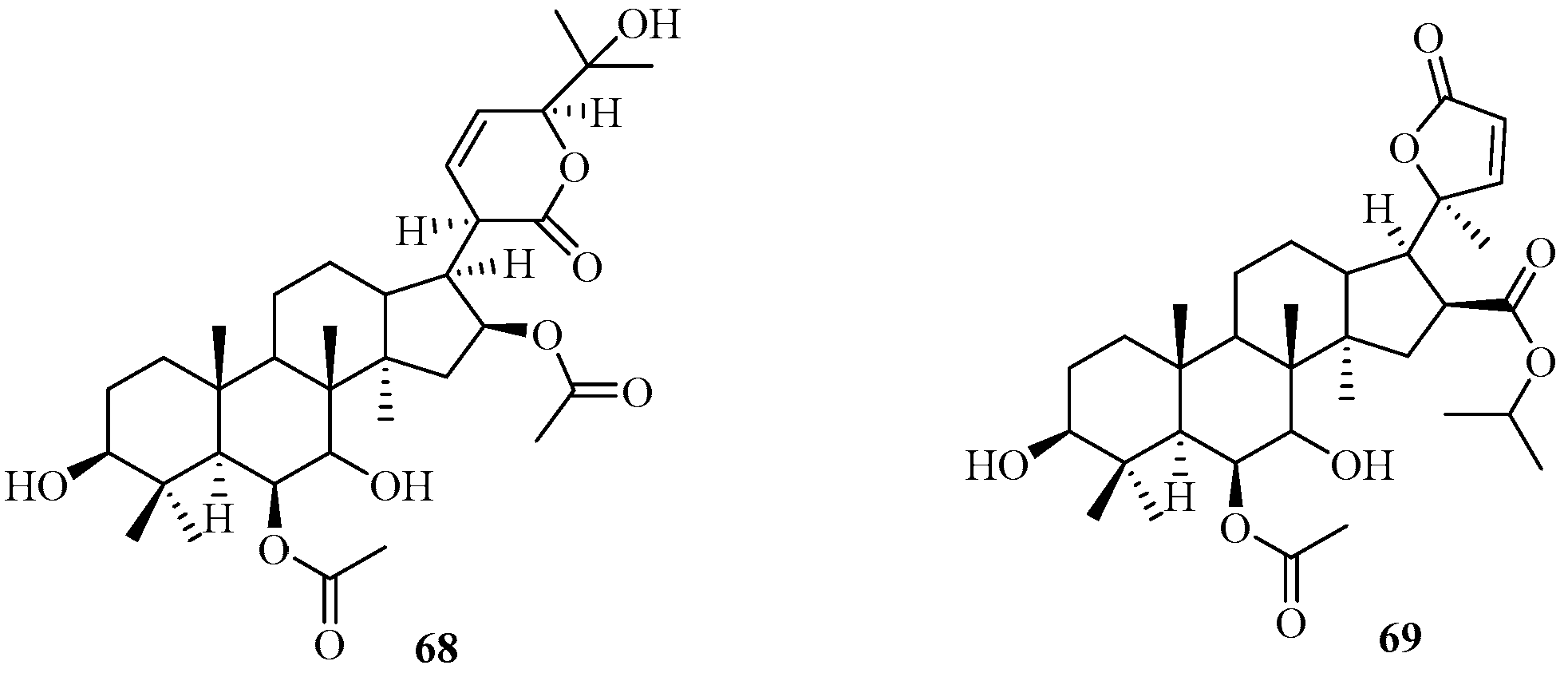
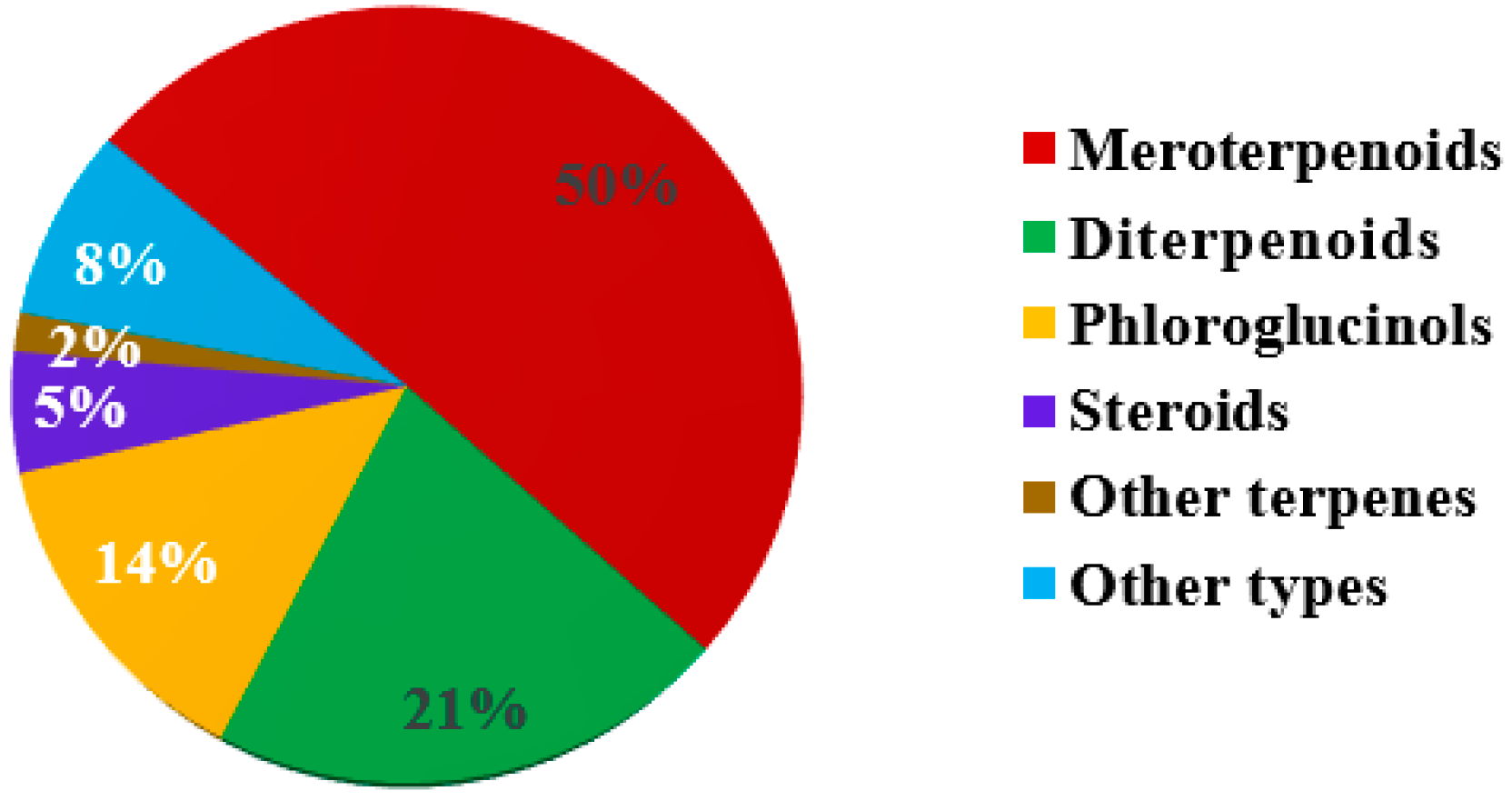
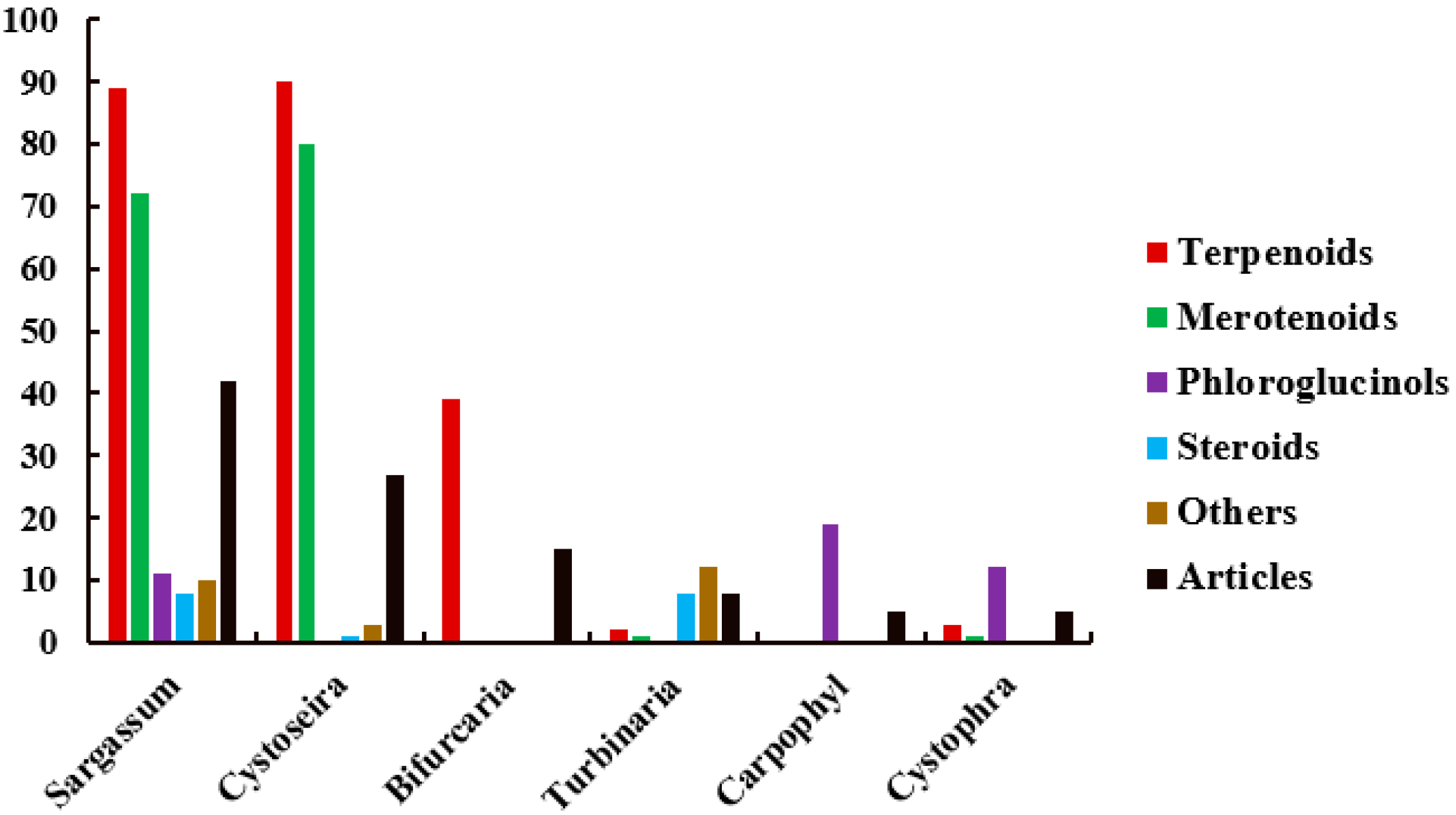
| Species | Sampling Locations | Compounds and Types | Ref. |
|---|---|---|---|
| Cystoseira schiffneri | Chebba, Tunisia | 1 (monoterpenoid) | [27] |
| C. crinita | Catania, Sicily, Italy | 3, 42–44, 58 (sesquiterpenoid and diterpenoids) | [31,46] |
| South coast of Sardinia, Italy | 70, 71, 73–78, 80, 81 (meroterpenoids) | [57] | |
| Toulon, France | 72, 79, 82 (meroterpenoids) | [58] | |
| C. myrica | El-Zaafarana, Egypt | 63–66 (diterpenoids) | [52] |
| Fayed, Egypt | 266 (steroids) | [117] | |
| C. abies-marina | Mosteiros, Portugal | 83, 84, 87, 88 (meroterpenoids) | [59] |
| Punta del Hidalgo, Spain | 85, 86, 304 (meroterpenoids, ketone) | [60] | |
| C. amentacea var. stricta | Le Brusc, Toulon, France | 89, 166 (meroterpenoids) | [62] |
| C. baccata | El Jadida, Morocco | 90, 91, 167–173 (meroterpenoids) | [63,88] |
| Cystoseira sp. | Montaña Clara Island, Spain | 92, 93, 174–176 (meroterpenoids) | [64] |
| C. balearica | Portopalo, Sicily, Italy | 94 (meroterpenoid) | [66] |
| C. stricta var. amentacea | Castelluccio, Syracuse, Sicily, Italy | 95, 96, 104–107 (meroterpenoids) | [67,71] |
| C. stricta | Acicastello, Catania, Sicily, Italy | 97–100, 108, 109 (meroterpenoids) | [67,68,72] |
| Portopalo, Sicily, Italy | 103 (meroterpenoid) | [70] | |
| C. stricta var. spicata | near Cava d’Aliga, Italy | 101, 102 (meroterpenoids) | [69] |
| C. tamariscifolia | Mediterranean Sea, Algeria | 110–113, 177 (meroterpenoids) | [73] |
| C. usneoides | Mediterranean coast, Morocco | 114–119 (meroterpenoids) | [74] |
| Tarifa, Spain | 120–131 (meroterpenoids) | [75] | |
| Sesimbra and Cabo Espichel, Portugal | 132–135 (meroterpenoids) | [76,77] | |
| C. sauvageuana | Aci Castello, Sicily, Italy | 136, 137 (meroterpenoids) | [78] |
| C. barbata | Salses, France | 306, 307 (lipids) | [136] |
| Sargassum naozhouense | Leizhou Peninsula, China | 2, 305 (monoterpenoid and amide) | [28,135] |
| S. hemiphyllum | Heda Coast, Izu Peninsula, Japan | 4–6 (norditerpenoids) | [32] |
| S. micracanthum | Kominato, Chiba, Japan | 7–14 (norditerpenoids) | [33] |
| Coast of Gosa, Japan | 15, 16 (norditerpenoids) | [34] | |
| Coast of Toyama Bay, Japan | 144–147, 179, 180 (meroterpenoids) | [82,91] | |
| Wando County, Korea | 227 (phloroglucinol) | [106] | |
| S. ilicifolium | Gulf of Manner, India | 67 (diterpenoid) | [53] |
| S. fallax | Governor Reef near Indented Head, Port Phillip Bay, Australia | 139, 140, 178 (meroterpenoids) | [80] |
| S. macrocarpum | Coast of Tsukumowan, Japan | 141–143 (meroterpenoids) | [81] |
| S. paradoxum | Governor Reef near Indented Head, Australia | 148–151 (meroterpenoids) | [83] |
| S. sagamianum | Manazuru, Japan | 152–154, 181, 182 (meroterpenoids) | [84] |
| Jeju Island, South Korea | 297 (glyceride) | [131] | |
| S. sagamianum var. yezoense | Oshoro Bay, Japan | 155, 156 (meroterpenoids) | [85] |
| S. siliquastrum | Jeju Island, Korea | 157, 158, 215–223, 184–206 (meroterpenoids) | [86,93,94,95,96] |
| Seashore of Pusan, Korea | 183 (meroterpenoids) | [92] | |
| S. tortile | Awa-Kominato, Chiba, Japan | 159–165 (meroterpenoids) | [87] |
| Tanabe Bay, Japan | 210–213 (meroterpenoids) | [99] | |
| Wakasa Bay, Japan | 214 (meroterpenoid) | [100,101] | |
| S. thun(m)bergii | Coast of Busan, Korea | 208, 209 (meroterpenoids) | [98] |
| Muroran, Japan | 273 (steroid) | [122] | |
| Nanji Island, East China Sea, China | 274 (steroid) | [123] | |
| West Sea, Korea | 298, 299 (glycolipids) | [132] | |
| Weihai, Shandong, China | 300, 301 (resorcinols) | [133] | |
| S. nigrifoloides | Nanji Island, Zhejiang, China | 224–226 (phloroglucinols) | [105] |
| S. spinuligerum | Wangaparoa Island, New Zealand | 228, 235–239 (phloroglucinols) | [107,109] |
| Auckland Harbour, New Zealand | 245, 249 (phlorotannins) | [111] | |
| S. patens | Coast of Noto Peninsula, Japan | 265 (phlorotannins) | [116] |
| S. asperifolium | Hurghada, Egypt | 267 (steroid) | [118] |
| S. carpophyllum | South China Sea, Beihai, China | 268, 269 (steroids) | [119] |
| S. fusiforme | Anhui Bozhou Xiancheng Pharmaceutical Limited Company, China | 270, 271 (steroids) | [120] |
| S. polycystcum | Weizhou Island, Beihai, China | 272 (steroid) | [121] |
| S. parvivesiculosum | Sanya, Hainan, China | 295, 296 (glycerols) | [130] |
| S. cinereum | Red Sea, Hurghada, Egypt | 302, 303 (aryl cresols) | [134] |
| Cystophora moniliformis | Port Phillip Bay, Victoria, Australia | 17–19 (norditerpenoids) | [35] |
| C. harveyi | East of Cape Leeuwin Lighthouse, Australia | 138 (meroterpenoid) | [79] |
| C. torulosa | Whangaparoa, New Zealand | 238–251 (phlorotannins) | [109,110,111] |
| Bifurcaria bifurcata | Atlantic coasts of Morocco | 20–22, 24–26, 60, 62 (linear diterpenoids) | [36,37,39,51] |
| Oualidia, Morocco | 23, 27, 59, 61 (linear diterpenoids) | [38,40] | |
| Roscoff, Brittany, France | 28, 29, 50–57 (linear diterpenoids) | [41,42,43,44,45,46,47,48,49,50] | |
| Kilkee, County Clare of Ireland | 30–39, 45 (linear diterpenoids) | [42,43,44] | |
| Quiberon, Brittany, France | 40, 41, 46–48 (linear diterpenoids) | [45] | |
| Near Piriac, France | 49 (linear diterpenoid) | [47] | |
| Turbinaria conoides | Gulf of Manner, India | 207, 283–288 (meroterpenoid, macrolides, and pyranoids) | [97,126,127] |
| Salin Munthal, Gulf of Mannar, India | 275, 276 (steroids) | [124] | |
| Kenting, Taiwan, China | 277–282 (steroids) | [125] | |
| T. ornata | Indian peninsular, India | 289–291 (furanones) | [128] |
| Gulf of Manner, India | 292–294 (spiroketals) | [129] | |
| T. decurrens | Mandapam region, India | 68, 69 (triterpenes) | [54] |
| Carpophyllum maschalocarpum | Torbay, north of Auckland, New Zealand | 229–234, 252, 253, 257–261 (phlorotannins) | [108,112,114] |
| C. angustifolium | Panetiki Island, Cape Rodney, New Zealand | 254–256, 262–264 (phlorotannins) | [113,115] |
| Activity Class | Compounds | Biological Activities | Ref. |
|---|---|---|---|
| Cytotoxicity | 4–6 | against P388, IC50: 5.1, 2.2, and 50 μg/mL | [32] |
| 132, 133 | against P388, IC50: 0.8 and 1.5 μg/mL | [76] | |
| against A-549, IC50: 1.25 and 1.4 μg/mL | [76] | ||
| 134, 135 | against P-388, IC50: 3.2 and 6.8 μg/mL | [77] | |
| against L-1210, inhibition rate: 50–100%, 10–20 μg/mL | [77] | ||
| against A-549, inhibition rate: 50–70%, 20 μg/mL | [77] | ||
| 139, 140, 178 | against P388, IC50 > 27–29 μM | [80] | |
| 210–213 | against P388, ED50: 20.8, 14.0, 16.8 and 5.7 μg/mL | [99] | |
| 279–282 | against P-388, ED50: 0.6, 0.8, 0.9 and 0.4 μg/mL | [125] | |
| against KB, ED50: 5.9, 4.0, 4.6 and 1.8 μg/mL | [125] | ||
| against A-549, ED50: 3.1, 2.5, 2.3 and 1.8 μg/mL | [125] | ||
| against HT-29, ED50: 0.4, 1.4, 1.2 and 1.7 μg/mL | [125] | ||
| 307 | against P388 in mice in vivo at 40 mg/kg | [136] | |
| 21, 22 | against NSCLC-N6, IC50: 12.3 and 9.5 μg/mL | [37] | |
| 31 | against MDA-MB-231, inhibition rate: 78.8%, 100 μg/mL | [43] | |
| 35 | against MDA-MB-231, IC50: 30.7 μg/mL | [44] | |
| 63–66 | against KA3IT, IC50: 10, 5, 5 and 5 μg/mL | [52] | |
| 83, 84, 87 | against Hela in Log and Lag phases, IC50: 17.3–25.0, 20.1–32.0 and 2.8–10.2 μg/mL | [59] | |
| 152, 153, 181 | against Hela S3, IC50: 10, 4.0 and 10 μg/mL | [84] | |
| 144–146 | against Colon 26-L5, IC50: 1.51, 17.5 and 1.69 μg/mL | [82] | |
| 204 | against AGS, HT-29 and HT-1080, IC50: 6.5, 3.4 and 13.9 μg/mL | [95] | |
| 266 | against HEPG-2 and HCT116, IC50: 2.96 and 12.38 μM | [117] | |
| 302 | against HepG2, MCF-7 and Caco-2, IC50: 14.5, 17.6 and 18.2Μm | [134] | |
| 303 | against HepG2, MCF-7, and Caco-2, IC50: 13.1, 12.7 and 11.2 μM | [134] | |
| 268 | against HL-60, IC50: 2.96 μg/mL | [119] | |
| causing morphological abnormality of Pyricularia oryzae mycelia, MMDC: 63 μg/mL | [119] | ||
| 269 | causing morphological abnormality of P. oryzae mycelia, MMDC: 250 μg/mL | [119] | |
| 28, 62, 89 | against Paracentrotus lividus, ED50: 12, 4 and 12 μg/mL | [41,51,62] | |
| Anti-inflammatory | 67 | inhibit COX-1/2 and 5-LOX, IC50: 3.52, 2.47 and 4.70 mM | [53] |
| 68, 69 | inhibit COX-1, IC50: 21.62 and 22.02 μM | [54] | |
| inhibit COX-2, IC50: 15.51 and 13.98 μM | [54] | ||
| inhibit 5-LOX, IC50: 3.92 and 3.02 μM | [54] | ||
| 207 | inhibit COX-2 and 5-LOX, IC50: 1.47 and 3.70 μM | [97] | |
| 283–288 | inhibit COX-1, IC50: 3.13, 3.19, 3.35, 4.06, 5.11 and 5.23 mM | [126,127] | |
| inhibit COX-2, IC50: 1.75, 1.93, 1.99, 2.15, 2.93 and 3.27 mM | [126,127] | ||
| inhibit 5-LOX, IC50: 4.24, 4.88, 5.07, 2.41, 2.99 and 3.22 mM | [126,127] | ||
| 297 | inhibit COX-2 and sPLA2-IIA, inhibition rate: 35.6%, 50 μM; 26.1%, 10 μM | [131] | |
| 114, 115, 117 | TNF-α inhibition, inhibition rate: 11–33%, 6–10 μM | [74] | |
| 120 | TNF-α inhibition, inhibition rate: 81%, 10 μM | [75] | |
| 121, 123, 127, 129, 130 | TNF-α inhibition, inhibition rate: 21–35%, 8–10 μM | [75] | |
| 125 | TNF-α inhibition, inhibition rate: 79%, 8 μM | [75] | |
| 128 | 59% inhibition against TNF-α at 5 μM | [75] | |
| Antioxidant | 67 | scavenge DPPH and ABTS+ radicals, IC50: 1.26 and 1.38 mM | [53] |
| 70, 71, 73–78, 80, 81 | scavenge DPPH radicals, scavenging rate: 29.0–96.7%, 164–230 μM | [57] | |
| 87, 88 | scavenge DPPH radicals, scavenging rate: 29–30%, 500 μg/mL | [59] | |
| 114–117 | scavenge ABTS˙+ radicals, EC50: 22.5–55.9 μM | [72] | |
| 120–125, 127–130 | scavenge ABTS˙+ radicals, EC50: 14.81–32.41 μM | [75] | |
| 144–146 | inhibition lipid peroxidation, IC50: 0.95–44.3 μg/mL | [82] | |
| scavenge DPPH radicals, IC50: 3.00– 52.6 μg/mL | [82] | ||
| 157 | scavenge DPPH radicals, RC50: 0.24 μg/mL | [86] | |
| 183 | scavenge DPPH radicals, scavenging rate: 96.07%, 0.5 mg/mL | [92] | |
| 187–202 | scavenge DPPH radicals, scavenging rate: 87–91%, 100 μg/mL | [94] | |
| 205, 206 | scavenge DPPH radicals, EC50: 31.1–57.1 mM | [96] | |
| scavenge ABTS+ radicals, EC50: 15.8–28.1 μM | [96] | ||
| 207 | scavenge DPPH and ABTS+ radicals, IC50: 24.25 and 24.32 μM | [97] | |
| 208, 209 | scavenge DPPH radicals, EC50: 30 and 31 μg/mL | [98] | |
| scavenge authentic/induced ONOO-, scavenging rate: 60/98.6%, 57.1/90.6% | [98] | ||
| 215–219 | scavenge DPPH radicals, RC50: 11.72–23.23 μg/mL | [86] | |
| 220–223 | scavenge DPPH radicals, RC50: 0.10–0.33 μg/mL | [86] | |
| 227 | scavenge ABTS+ radicals, IC50: 47 μM | [106] | |
| 283–285 | scavenge DPPH radicals, IC50: 1.20, 1.35 and 1.54 mM | [126] | |
| scavenge ABTS+ radicals, IC50: 1.48, 1.54, and 1.81mM | [126] | ||
| 286–288 | scavenge DPPH radicals, IC50: 0.54, 0.54 and 0.68 mg/mL | [127] | |
| scavenge ABTS+ radicals, IC50: 0.58, 0.58 and 0.76 mg/mL | [127] | ||
| 289–291 | scavenge DPPH radicals, IC50: 1.16, 1.05 and 1.21 mM | [128] | |
| scavenge ABTS+ radicals, IC50: 1.38, 1.24 and 1.41 mM | [128] | ||
| 292–294 | scavenge DPPH radicals, IC50: 1.14, 1.25 and 1.42 mM | [129] | |
| scavenge ABTS+ radicals, IC50: 1.28, 1.34 and 1.71 mM | [129] | ||
| 184–186 | reduce ROS formation in HT 1080 cells by over 67.2% at 5 μg/mL | [93] | |
| inhibit lipid peroxidation induced by H2O2 | [93] | ||
| increase GSH levels in HT1080 cells at 5 μg/mL | [93] | ||
| Antifouling | 110–113, 177 | against Pseudoalteromonas elyakovii, Vibrio aesturianus, Polaribacter irgensii, Halosphaeriopsis mediosetigera, Asteromyces cruciatus, and Lulworthia uniseptate, MIC: 0.1–10 μg/mL | [73] |
| against Exanthemachrysis gayraliae, Cylindrotheca closterium, Pleurochrysis roscoffensis, Ulva intestinalis, and Undaria pinnatifida, MIC: 0.1–10 μg/mL | [73] | ||
| 168 | against Sargassum muticum and phenoloxidase, IC50: 2.5 and 1 μg/mL | [63] | |
| 169 | against S. muticum, U. intestinalis, phenoloxidase, and E. gayraliae, IC50: 1 μg/mL | [63] | |
| 171 | against U. intestinalis and phenoloxidase, IC50: 2.5 and 2.5 μg/mL | [63] | |
| Antimicrobial | 149–151 | against Streptococcus pyogenes (345/1), zones of inhibition: 1–3 mm, 1 mg/mL | [83] |
| 152, 153, 181 | against Bacillus subtilis and Staphylococcus aureus, inhibition rate: ca. 30 and 80% | [84] | |
| 157 | slight inhibition against isocitrate lyase from S. aureus | [86] | |
| 158, 215–223 | weak inhibition AGAINST sortase A from Candida albicans | [86] | |
| 275 | against Staphylococcus aureus, S. epidermidis, Escherichia coli and Pseudomonas aeruginosa, MIC: 32–128 μg/mL | [124] | |
| against Candida albicans and Aspergillus niger, MIC: 16 μg/mL | [124] | ||
| 276 | against S. aureus, S. epidermidis, E. coli and P. aeruginosa, MIC: 32–128 μg/mL | [124] | |
| against C. albicans and A. niger, MIC: 4 and 2 μg/mL | [124] | ||
| Anti-Alzheimer’s disease | 193, 201 | butylcholine esterase inhibition, inhibition rates: 82.7 or 80% | [94] |
| 224–226 | against CDK5, IC50: 12, 18 and 17 μM | [105] | |
| against GSK3β, IC50: 1.6, 1.1 and 1.8 μM | [105] | ||
| Antidiabetic | 265 | against α-amylase and α-glucosidase with IC50 values of 3.2 and 25.4–114 μg/mL, respectively | [116] |
| 274 | PTP1B inhibition, IC50: 2.24 mM | [123] | |
| 283–285 | PTP-1B inhibition, IC50: 1.39, 2.33 and 3.13 mM | [126] | |
| 289–291 | PTP-1B inhibition, IC50: 2.58, 2.42 and 2.77 mM | [128] | |
| α-amylase inhibition, IC50: 0.39, 0.31 and 0.48 mM | [128] | ||
| α-glucosidase inhibition, IC50: 0.34, 0.27 and 0.44 mM | [128] | ||
| Antihypertensive | 283–285 | ACE-I inhibition, IC50: 1.23, 1.89 and 2.23 mM | [126] |
| 292–294 | ACE-I inhibition, IC50: 4.55, 4.72 and 4.86 mM | [129] | |
| Antiprotozoal | 30 | against Plasmodium falciparum, IC50: 0.65 μg/mL | [42] |
| Antiviral | 132–135 | against CV-1, IC50: 4.0, 1.0, 3.6 and 4.0 μg/mL | [76,77] |
| against BHK, IC50: 6.2, 1.1, 3.7 and 6.2 μg/mL | [76,77] | ||
| Antiglycation | 141–143 | AGEs inhibition, IC50: 2.1, 2.6 and 1.0 mM | [81] |
| Antiphotoaging | 172, 173 | photodamage attenuation effect, cell viability value: 82.6–95.1%, 5–20 μg/mL | [90] |
Disclaimer/Publisher’s Note: The statements, opinions and data contained in all publications are solely those of the individual author(s) and contributor(s) and not of MDPI and/or the editor(s). MDPI and/or the editor(s) disclaim responsibility for any injury to people or property resulting from any ideas, methods, instructions or products referred to in the content. |
© 2024 by the authors. Licensee MDPI, Basel, Switzerland. This article is an open access article distributed under the terms and conditions of the Creative Commons Attribution (CC BY) license (https://creativecommons.org/licenses/by/4.0/).
Share and Cite
Peng, Y.; Yang, X.; Huang, R.; Ren, B.; Chen, B.; Liu, Y.; Zhang, H. Diversified Chemical Structures and Bioactivities of the Chemical Constituents Found in the Brown Algae Family Sargassaceae. Mar. Drugs 2024, 22, 59. https://doi.org/10.3390/md22020059
Peng Y, Yang X, Huang R, Ren B, Chen B, Liu Y, Zhang H. Diversified Chemical Structures and Bioactivities of the Chemical Constituents Found in the Brown Algae Family Sargassaceae. Marine Drugs. 2024; 22(2):59. https://doi.org/10.3390/md22020059
Chicago/Turabian StylePeng, Yan, Xianwen Yang, Riming Huang, Bin Ren, Bin Chen, Yonghong Liu, and Hongjie Zhang. 2024. "Diversified Chemical Structures and Bioactivities of the Chemical Constituents Found in the Brown Algae Family Sargassaceae" Marine Drugs 22, no. 2: 59. https://doi.org/10.3390/md22020059
APA StylePeng, Y., Yang, X., Huang, R., Ren, B., Chen, B., Liu, Y., & Zhang, H. (2024). Diversified Chemical Structures and Bioactivities of the Chemical Constituents Found in the Brown Algae Family Sargassaceae. Marine Drugs, 22(2), 59. https://doi.org/10.3390/md22020059









